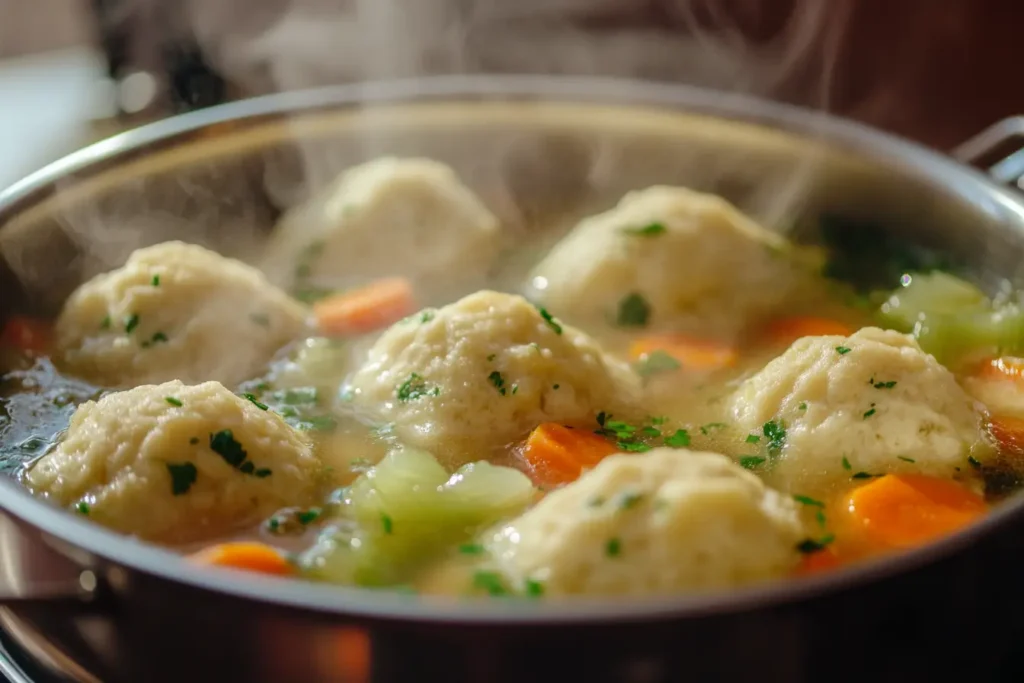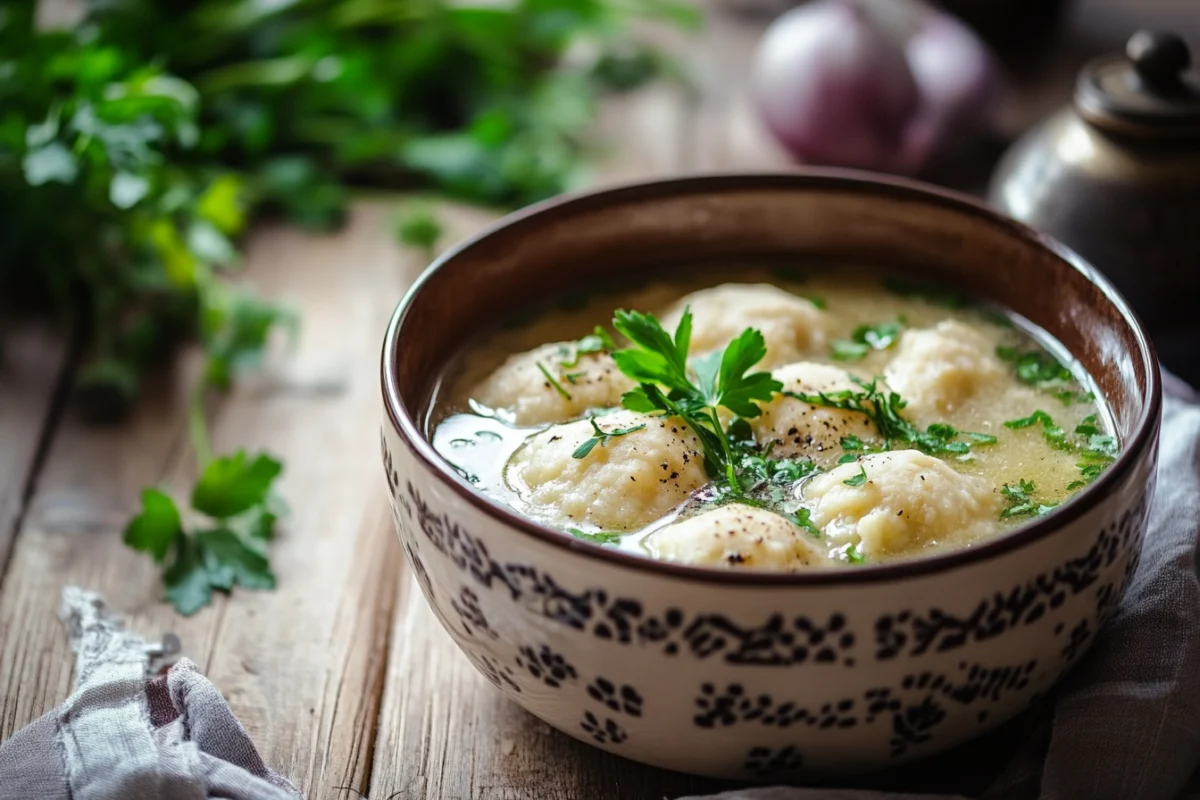Dumplings are the heart of many comforting dishes, but how do you keep biscuit dumplings from falling apart? Whether you’re new to the kitchen or a seasoned cook, mastering this essential skill can make all the difference in your culinary creations. This guide dives deep into the reasons dumplings fail, offering practical tips, foolproof recipes, and adjustments for gluten-free and vegan diets. Let’s explore how to make your biscuit dumplings perfectly fluffy and intact every time!
Understanding Biscuit Dumplings
What Are Biscuit Dumplings?
Biscuit dumplings are tender, pillowy dough balls typically cooked in a flavorful liquid, like soup or stew. They’re a quick and easy alternative to traditional dumplings, often made from biscuit dough or even pre-made dough mixtures. Popular in comfort food classics like chicken and dumplings, biscuit dumplings are beloved for their fluffy texture and ability to soak up savory flavors.
These little gems are versatile, lending themselves to both savory and sweet dishes. Their simplicity, however, often masks how delicate they can be—without proper care, they may crumble or dissolve during cooking.
Common Issues with Biscuit Dumplings Falling Apart
If your dumplings disintegrate, it’s likely due to one of these common culprits:
- Improper Dough Consistency
- A dough that’s too wet lacks the structure to hold together. Conversely, overly dry dough may crack under pressure. Striking the perfect balance is key.
- Incorrect Cooking Techniques
- Dropping dumplings into boiling liquid or stirring them too vigorously can cause them to break apart. Gentle handling is crucial.
- Lack of Binding Agents
- Ingredients like eggs and milk act as glue to hold the dough together. Skipping these or using them in the wrong proportions can spell disaster.
- Overcooking or Undercooking
- Timing matters. Undercooked dumplings are raw and fragile, while overcooked ones can lose their shape.
Understanding these pitfalls is the first step toward making perfect biscuit dumplings every time. In the next sections, we’ll delve into the science and techniques you need to ensure success. Get ready to make dumplings that are as durable as they are delicious!
The Science Behind Dumpling Integrity
Importance of Proper Binding Agents
Binding agents are the unsung heroes of perfect biscuit dumplings. Ingredients like eggs and milk give the dough the structure it needs to hold together during cooking. Without them, your dumplings might crumble apart in the pot. Eggs provide protein that strengthens the dough, while milk adds both moisture and richness, ensuring a cohesive texture.
For those avoiding eggs, alternatives like flaxseed meal or chia seeds mixed with water can work as a substitute. Just make sure to mix thoroughly to maintain the perfect balance of ingredients. Using too little binding agent can weaken the dough, while too much may make it sticky and unmanageable.
How Temperature Affects Dumpling Consistency
Cooking temperature plays a crucial role in keeping your biscuit dumplings intact. Learn more about how boiling points affect food here. High heat can cause them to cook unevenly, making the outside tough while leaving the center underdone. On the other hand, a simmer ensures gentle cooking, which allows the dumplings to hold their shape.
Always avoid boiling the liquid vigorously after adding dumplings. The agitation can break them apart. Instead, reduce the heat to a gentle simmer and let the dumplings float undisturbed. This approach is key to preventing your dumplings from falling apart and achieving that sought-after fluffy texture.
For more detailed tips on how to manage cooking temperature, check out this guide on Bisquick dumpling recipes.
Moisture Balance in Dough
Too much moisture in your dumpling dough can lead to a sticky mess that’s prone to breaking apart. On the flip side, a dry dough is brittle and hard to shape. Striking the right balance is essential. The dough should feel slightly tacky but not cling to your fingers excessively.
Adjust the moisture level by gradually adding liquid instead of dumping it all at once. If the dough is too sticky, dust it lightly with flour until it’s easier to handle. Following this simple adjustment ensures your biscuit dumplings stay intact from mixing bowl to serving dish.
Tips and Tricks to Prevent Falling Apart
Key Steps in Mixing Dough Correctly

Mixing dough might seem straightforward, but overmixing is a common pitfall that can ruin biscuit dumplings. Overworking the dough activates gluten, making it tough and prone to falling apart when cooked. Instead, mix the ingredients just until combined, leaving the dough slightly lumpy.
Using a fork or wooden spoon is ideal for mixing, as they’re gentle on the dough. Incorporating all ingredients uniformly without overworking them ensures a delicate texture that won’t crumble under pressure.
Cooking Techniques for Perfect Dumplings
Cooking biscuit dumplings involves more than dropping dough into broth. The key is to do it gently. Use a spoon to scoop small, even portions of dough, then lower them into the simmering liquid carefully. Space them apart to avoid overcrowding, which can lead to uneven cooking.
Cover the pot while cooking to trap steam, which helps cook the dumplings evenly. For a detailed comparison of cooking methods, read this article on cooking dumplings covered or uncovered.
Ingredients That Enhance Dumpling Durability
Adding a pinch of baking powder to your biscuit dough can make a world of difference. Baking powder helps the dumplings rise and keeps them light. Additionally, using buttermilk instead of regular milk can create a tangy, robust dough that holds together well.
For more advanced recipes, you might explore adding herbs or shredded cheese to the dough. These ingredients not only boost flavor but also contribute to the structural integrity of the dumplings.
Part 4: Recipe Adjustments for Robust Dumplings
Modifications to Standard Recipes
Sometimes, small tweaks to your recipe can make all the difference in keeping biscuit dumplings from falling apart. For instance, using self-rising flour instead of all-purpose flour provides a built-in leavening agent that enhances the dumplings’ structure. Adding a bit of cornstarch can also improve the dough’s stability, especially when cooking in broths or stews.
Consider replacing regular milk with buttermilk or yogurt for a richer texture and slightly tangy flavor. These ingredients not only improve flavor but also help bind the dough better. Additionally, reducing the liquid content slightly can yield a sturdier dough that holds its shape during cooking.
For more tips on perfecting your dumplings, visit our guide on how to keep Bisquick dumplings from falling apart.
Recipes to Try for Beginners
If you’re new to making dumplings, start with simple recipes that are forgiving. A basic dumpling recipe using pre-made biscuit dough is an excellent way to learn. Pre-made dough has the ideal consistency, eliminating the guesswork of mixing.
For those ready to experiment, try a recipe that incorporates fresh herbs, such as parsley or dill, for added flavor. A cheesy dumpling recipe with shredded cheddar is another beginner-friendly option that stays intact while adding a delicious twist.
Want to explore more easy recipes? Check out this Bisquick dumpling recipe for step-by-step instructions.
FAQs on Biscuit Dumplings
Why Do My Biscuit Dumplings Fall Apart?
The most common reasons for biscuit dumplings falling apart include using dough that’s too wet, cooking at an excessively high temperature, or skipping binding agents like eggs. To ensure success, always maintain the right dough consistency and simmer instead of boiling.
Can I Fix Dumplings That Are Too Soft?
Yes! If your dumplings feel too soft, try adding a bit of flour to the dough before cooking. Alternatively, reduce the cooking time slightly to prevent over-softening. For ready-to-cook dumplings that remain firm, experiment with pre-made dough or a tested recipe.
Is It Better to Use Homemade or Prepackaged Dough?
Both options have their advantages. Homemade dough gives you full control over ingredients, while prepackaged dough ensures consistent results. For busy weeknights, prepackaged dough is a lifesaver, and it’s less likely to fall apart during cooking.
How Do I Store Leftover Dumplings Without Them Falling Apart?
Leftover dumplings should be stored in an airtight container with a small amount of broth to keep them moist. Avoid reheating in the microwave, as it can make them mushy. Instead, reheat gently on the stovetop to maintain their structure.
For more helpful tips and delicious ideas, explore our other recipes and guides on Peaceful Recipes. Whether you’re a novice or a seasoned cook, mastering dumplings is within your reach! Let me know if you’d like to expand or refine any part further.
Advanced Techniques for Perfect Dumplings
Incorporating Add-Ins for Texture and Flavor
If you’re looking to take your dumplings to the next level, adding ingredients like shredded cheese, herbs, or even finely chopped vegetables can make them more flavorful and sturdy. Cheese, for instance, melts slightly during cooking, helping to bind the dough while also adding a rich taste. Fresh herbs like parsley or thyme not only enhance the flavor but also contribute to the dough’s texture.
For best results, fold these add-ins gently into the dough. Overmixing can toughen the dumplings, which might lead to them breaking apart. Experiment with different combinations to find your favorite mix.
Using Steam to Maintain Structure
Cooking your biscuit dumplings with steam is another effective way to keep them from falling apart. When you cover the pot during cooking, the steam helps evenly cook the dumplings without disturbing their structure. This method is especially helpful if your broth tends to boil vigorously.
To maximize this technique, ensure the lid is tight-fitting, and resist the urge to lift it frequently. The trapped steam is critical for even cooking and achieving that perfect fluffy texture.
Common Mistakes and How to Avoid Them
Overcrowding the Pot
One of the most frequent mistakes when cooking biscuit dumplings is overcrowding the pot. When too many dumplings are added at once, they don’t have enough room to expand properly. This can cause them to stick together or cook unevenly, leading to breakage.
To avoid this, cook the dumplings in batches if necessary. Space them apart in the pot, ensuring each dumpling has enough room to float freely. This small adjustment makes a big difference in achieving intact, well-cooked dumplings.
Skipping the Resting Period
Another common issue is skipping the resting period for the dough. Allowing the dough to rest for a few minutes before cooking helps the ingredients fully hydrate and improves the dough’s elasticity. Without this step, the dumplings may fall apart as soon as they hit the liquid.
Plan for a 5-10 minute rest period after mixing the dough. During this time, you can prep your broth or stew, making the process seamless and efficient.
Forgetting to Test the Liquid
Before adding your dumplings, always test the liquid’s temperature. If it’s boiling too vigorously, wait a moment for it to calm down. A gentle simmer is the sweet spot for cooking biscuit dumplings. Dropping dumplings into a boiling liquid often leads to disintegration, so keeping the liquid at a steady simmer is crucial.
By avoiding these common mistakes, you’ll have a much easier time ensuring your biscuit dumplings turn out just right. With these advanced techniques and tips in your cooking arsenal, you’re well on your way to mastering how to keep biscuit dumplings from falling apart.
Adapting Dumplings for Special Diets
Gluten-Free Biscuit Dumplings
For those following a gluten-free diet, traditional recipes might seem out of reach. However, with a few adjustments, you can still enjoy dumplings that are both delicious and sturdy. Start by substituting all-purpose flour with a gluten-free flour blend. Ensure the blend includes xanthan gum or guar gum, as these help bind the dough and prevent it from crumbling.
When making gluten-free dumplings, it’s especially important to avoid overmixing the dough. Stirring too much can make it dense and prone to falling apart. For extra durability, consider adding an egg or a tablespoon of flaxseed meal mixed with water. These additions improve the texture and help answer the question, how do you keep biscuit dumplings from falling apart?
Vegan Biscuit Dumplings
Vegan dumplings can be just as satisfying as traditional ones. Use plant-based milk like almond or oat milk to moisten the dough. Replace eggs with a flax or chia seed mixture (1 tablespoon of seeds to 3 tablespoons of water, let sit for 5 minutes).
To add flavor, mix in nutritional yeast or finely chopped herbs. These ingredients not only enhance taste but also contribute to the dough’s structure. By making these swaps, you can enjoy fluffy, durable dumplings that cater to a vegan diet.
Pairing Dumplings with the Perfect Dishes
Classic Soups and Stews

Biscuit dumplings shine when paired with hearty soups and stews. Their fluffy texture absorbs the rich flavors of the broth, making them the ultimate comfort food. Popular pairings include chicken and dumplings, beef stew, and vegetable chowder. For these dishes, a slow simmer ensures the dumplings remain intact while cooking evenly.
If you’re looking for inspiration, try adding your dumplings to this cabbage and sausage recipe for a unique twist on a classic dish.
Sweet Dumpling Desserts
Biscuit dumplings aren’t limited to savory dishes—they can also be a delightful dessert. Drop dumplings into a bubbling fruit mixture, such as apple, peach, or cherry filling, and bake until golden. The dumplings soak up the sweet juices, creating a dessert that’s both comforting and satisfying.
For an extra indulgent treat, drizzle with caramel sauce or serve with a scoop of ice cream. This sweet adaptation proves that dumplings are versatile enough for any meal.
With these adaptations and pairing ideas, you can confidently create dumplings that suit every occasion and dietary need. Whether savory or sweet, knowing how to keep biscuit dumplings from falling apart ensures every bite is as delightful as it’s meant to be. Let me know if you’d like to continue with a conclusion or further expansion of any section!

